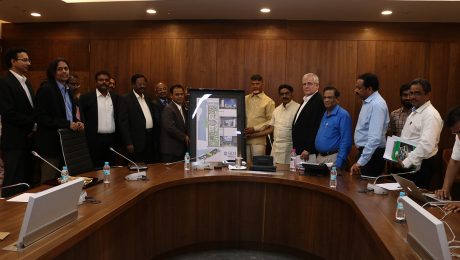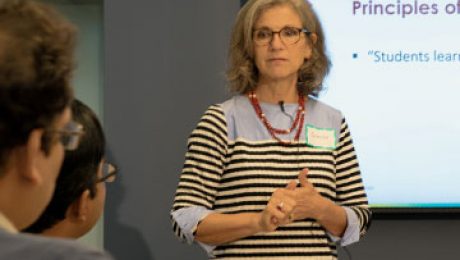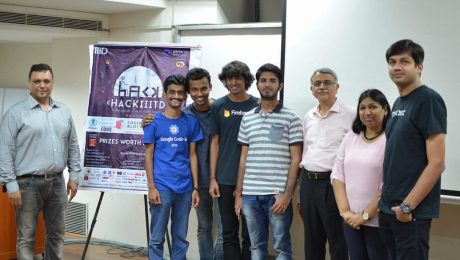TEAM NAVAN SECURE FIRST PRIZE AT A TECHNICAL COMPETITION IN BITS PILANI
“Team NAVAN” – a multi-disciplinary technical team, comprising of undergraduate students from various engineering branches such as Mechanical, EEE, Software and Information Technology participated in the technical competition APOGEE 2017, at BITS Pilani. The team is working on a project of a magnetic elevator which is based on the principle of magnetic levitation. The horizontal magnetic levitation is very commonly used but the vertical levitation is the most challenging work and team NAVAN has successfully completed the working model of the elevator which was presented at BITS Pilani and IIT Kanpur (results are awaited).
About 106 teams from reputed institutes including entrepreneurs had registered for the event but only 28 of them reached the final round and team NAVAN was one amongst them. In the finals, the teams were evaluated in different categories such as innovation, feasibility, robustness and working model. Team NAVAN scored high in all the categories and were declared “Winners” in the domain of Prototype project presentation under Design Appliances Category at APOGEE 2017.
The team’s motto is to work for the society as they believe that Engineering is to serve the society. Their upcoming works will focus on the “Society Need Products” and they have aimed to make products which will reach the market. The team is mentored by Mr.Shubrajit Bhaumik and Mr.Sodi Setty Prasad – Assistant Professors from the Department of Mechanical Engineering.
- Published in News
SRM University, AP – Amaravati Master Plan unveiled by Honourable Chief Minister of Andhra Pradesh, Mr. N. Chandrababu Naidu
The Honourable Chief Minister of Andhra Pradesh Mr. N Chandrababu Naidu unveiled the master plan for the new and fast upcoming SRM University, Andhra Pradesh, which is set to commence programs in engineering from August of this year.
“SRM is embracing a new method of learning, not seen before in India. We will emphasize practical and application oriented learning via projects and lab courses rather than monologues that are the typical feature of our classrooms. We would like to create a world class environment for our students here at SRM University, Andhra Pradesh; and we want to help them create tomorrow”, says Dr. P Sathyanarayanan, President of SRM University, Andhra Pradesh.
To help them in this endeavour SRM University, Andhra Pradesh has brought in many multinational institutions. Perkins + Will, a reputed international architecture firm with many decades of experience is conceptualizing the design of the university. This will be constructed by the eminent Shapoorji Pallonji Group. Aiding them in recruitment of senior administrative and academic members are international search firms Perret Laver and Society, who specialize in the higher education space.
SRM University, Andhra Pradesh is currently establishing partnerships with reputed international universities from the US, the UK and Singapore. With support from these international institutions, there will be a significant focus on both pure and applied research in areas of renewable energy, space technology, IoT, blue economy, nanotechnologies, and many more.“Developing research led universities is fundamental to the progress of the state and the nation. We aim to do just that by bringing solutions to the problems that plague today’s world”, says Dr. Narayana Rao, Pro – Vice Chancellor of SRM University, Andhra Pradesh.
This university is aimed to become first integrated inter disciplinary institutions offering courses in Engineering, Management, law, medical sciences, pure sciences and liberal arts.
Additionally, SRM University, Andhra Pradesh, along with the Chief Minister of AP, is launching an incubation centre “SHRISTI” – SRM Habitat for Research & Innovation in Science & Technology for Industries to make its university a hub of innovation of development.
SHRISTI aims to create 100 companies and generate 10,000 jobs in next 10 years. This innovation centre will provide customised build-up space and research infrastructure with supporting services.
- Published in News
Faculty of SRM University, AP – Amaravati participate in a design camp at Massachusetts Institute of Technology, USA
October 5-11, 2017
Massachusetts Institute of Technology, Cambridge, USA
As part of SRM University, AP – Amaravati’s engagement with Massachusetts Institute of Technology (MIT), USA, a design camp for SRM’s faculty was conducted to help prepare them to teach MIT’s courses. The design camp, conducted in MIT, emphasized on active and collaborative learning principles and practice, and gave faculty the necessary exposure to build on interactive, hands-on, technology-enabled experiences, and blended/hybrid delivery modes that combine online and face-to-face learning
The participants of the design camp were provided guidance on integration of MITx courses and OpenCourseWare material within relevant local contexts. The design camp also trained them on identifying learning outcomes, and alignment of curriculum design, course content, learning activities, and assessment with selected degree objectives of SRM University, Andhra Pradesh.
- Published in News
Students of SRM University, AP – Amaravati win IIIT Delhi’s annual hackathon
August 25, 2017, New Delhi
Two students from SRM University, Andhra Pradesh namely Rishabh Minocha and Shubham Rao attended an annual hackathon HACKIIITD, organized by IIIT-Delhi on the 25th of August. They emerged as the winners (1st Position) of the hackathon out of the 800 teams who had applied.
The teams were provided a set of themes out of which they could choose any to work on. Team Bash, which included Rishabh Minocha and Shubham Rao chose to work on “Reliability of Media”. Using the concept of Blockchain, a decentralized peer to peer anonymous network, the team worked on the theme by creating an application where users could vote on a particular article. Based on the consensus amongst the users, a piece of news would then be classified as reliable or not. If the news reaches the consensus, the users who up-voted the particular news would get a small amount of cryptocurrency (Ex. Bitcoin) for their research on that news.
The point of using the concept of Blockchain was so that if a particular news reaches the consensus, it could not be modified in any matter and hence the public would get the original piece of news.
- Published in News




